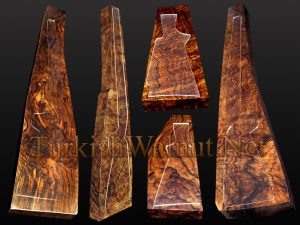The Different Grades of Walnut for Shotgun Stocks
In the world of firearms, the quality and type of material used to make the gun plays a significant role in determining its performance, longevity, and overall value. One of the most sought-after materials for shotgun stocks is walnut. Known for its aesthetic appeal, hardness, shock resistance, and grain texture, walnut has set the standard in the industry. This article will delve into the unique qualities of walnut as a material for shotgun stocks, explore the different grades of walnut, and provide guidance on selecting the best grade for your firearm. We will also discuss the impact of walnut grades on the performance of the shotgun stock.

Understanding the Unique Qualities of Walnut for Shotgun Stocks
Walnut has been a staple choice for gunsmiths since the early days of firearms. Its unique combination of hardness and shock resistance makes it ideal for absorbing the recoil of a shotgun, thus improving the shooter’s accuracy and comfort. Moreover, walnut has a tight grain structure, which makes it less likely to warp or shrink over time. This stability makes walnut an excellent choice for shotgun stocks that need to withstand harsh field conditions and heavy use.
In addition to its structural qualities, walnut also has an inherent aesthetic appeal. The unique patterns in the grain, coupled with the rich, warm color of the wood, make every shotgun stock a one-of-a-kind work of art. These patterns can be highlighted and enhanced through a process called checkering, which adds grip and further improves the functionality of the stock.
Finally, walnut is a dense wood, which adds a satisfying weight to the shotgun. This weight can help balance the gun and reduce felt recoil, providing additional stability and control for the shooter. Overall, the unique qualities of walnut make it a premium choice for shotgun stocks.
Exploring the Various Grades of Walnut Wood
Walnut wood for shotgun stocks is classified into different grades based on its quality, color, and grain pattern. The industry generally recognizes five grades: standard or field grade, fancy, extra fancy, exhibition, and special selection.

Standard or field grade walnut is the most common and affordable type. It has a straight, tight grain pattern and minimal figure, making it durable and suitable for everyday use. Fancy grade walnut features more pronounced grain patterns and color variety, giving the stocks a more decorative look.
Extra fancy walnut is a higher grade, with even more distinctive figure and color variations. Exhibition grade and special selection walnuts are the top-tier grades, offering the most stunning and unique grain patterns and colors. These premium grades are often reserved for collector’s items or custom-built shotguns.
Making the Right Choice: Selecting the Best Grade for Your Shotgun
Choosing the right grade of walnut for your shotgun depends primarily on your personal preferences and intended use of the gun. If you are looking for a workhorse shotgun for regular hunting or shooting sports, a standard or field grade walnut stock will serve you well. It offers durability and reliability without a high price tag.
On the other hand, if you want a shotgun with a more ornate look, you might consider a fancy or extra fancy grade walnut. These grades offer more aesthetic appeal without compromising on durability and performance.
If you’re a collector, or if you’re commissioning a custom-built shotgun, you might opt for an exhibition or special selection grade walnut. These high-end grades offer the most exquisite grain patterns and colors, turning your shotgun into a showpiece.

The Impact of Walnut Grades on Shotgun Stock Performance
While the grade of walnut can significantly impact the aesthetic appeal of a shotgun, it’s crucial to remember that it has minimal effect on the performance of the stock. Whether you choose a field grade or an exhibition grade walnut, your shotgun stock will still offer excellent recoil absorption, stability, and longevity.
However, the psychological impact of having a beautifully crafted shotgun should not be underestimated. For some shooters, the knowledge that they are holding a piece of art can enhance their shooting experience, make them feel more connected to the gun, and even improve their confidence and accuracy.
Moreover, higher-grade walnut stocks often come with better craftsmanship, which may include more ergonomic designs and higher-quality checkering. These factors can contribute to improved handling and comfort, subtly enhancing the performance of the shotgun.
In summary, walnut is a superior material for shotgun stocks due to its unique combination of hardness, stability, shock resistance, and aesthetic appeal. The various grades of walnut offer a range of options to suit different tastes and uses. Whether you’re a practical shooter or a gun enthusiast looking for a unique piece, there’s a grade of walnut that’s perfect for your shotgun stock. Remember, the grade of walnut may not dramatically affect the performance of your shotgun, but it can greatly enhance your shooting experience and overall satisfaction.


Comments